About UCMP : News and events : UCMP newsletter
Merriam and Alexander: the emergence of a museum
 |
 |
 |
 |
This is the third in a series of articles on the history of UCMP, adapted from a more detailed and referenced paper by Jere H. Lipps: 2004. Success story — the history and development of the Museum of Paleontology at the University of California, Berkeley. Proceedings of the California Academy of Sciences 55 (Suppl. I):209243. 22 figs.
|
 |
 |
 |
 |
 |
 |
 |
 |
 |
 |
 |
 |
John C. Merriam returned to Berkeley in 1894 as a faculty member supporting both geology and zoology, as planned by Joseph LeConte and Andrew Lawson. They thought a vertebrate paleontologist was an ideal choice. In spite of UC's financial problems and new competition from Stanford University across the bay, Merriam taught a complete array of undergraduate and graduate paleontology courses. Many of the famous early California paleontologists (below right) were trained at Berkeley under Merriam.
 |
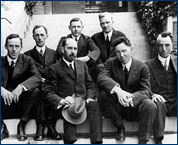
Faculty and instructors of the Department of Paleontology, c. 1915. Top row, right to left: E. L. Packard, W.S.W. Kew, J.O. Nomland. Bottom row, right to left: John P. Buwalda, John C. Merriam, Chester Stock, and Bruce L. Clark. If the date on this photograph is correct, then only Merriam was a professor at that time, although Buwalda, Stock, and Clark were appointed professors in geology a few years later.
|
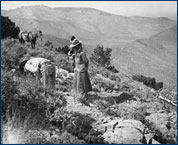
Annie Alexander watching the excavation of fossils on Merriam's Saurian Expedition, 1905, Humboldt County, Nevada.
|
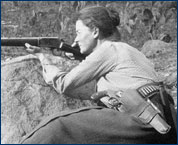
Annie Alexander posed with her gun on a field trip to the Fossil Lake region in Oregon in 1901.
|
Annie Alexander, a wealthy newcomer to the Bay Area, listened to Merriam lecture in 1900 and this began her lifelong enthusiasm for paleontology. A remarkable woman, she was vital to the development of paleontology, vertebrate biology, and botany at Berkeley (Stein 2001). After Merriam's course, Alexander organized and financed expeditions to collect fossils, and an expedition to Alaska to collect living animals. She supported Merriam's research and fossil collecting trips until 1920.
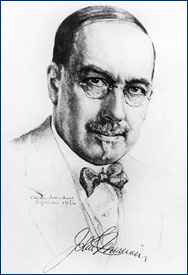
John C. Merriam, c. 1920.
|
 |
Merriam, an exceptional researcher, fossil collector, and prolific author, benefited from Alexander's financial support. He studied the Pleistocene Rancho La Brea vertebrates exclusively from 1905-1913 with the help of his former student Loye Holmes Miller. Their huge collection was sent to Berkeley and studied by Merriam and his students, and stored in the Campanile, where it still resides. Other faunas were studied as well. At the John Day fossil beds in Oregon, Merriam became fascinated with the idea that fossil beds could be a wonderful outdoor educational experience for the public, and he proposed that John Day become a state park preserved for posterity. It was not until 1974, some 29 years after his death, that his proposal was fulfilled and the John Day beds were declared a U.S. National Monument. Advocacy for preservation became an important role for Merriam. He led the Save the Redwoods League and urged the state to preserve important natural areas, such as Yosemite Valley (Mark 2005). Highly regarded at Berkeley, Merriam delivered the second Berkeley Faculty Research Lecture in 1914, and was appointed Dean in 1920.
Merriam fostered Annie Alexander's support for paleontology. She also met Joseph Grinnell in 1907 beginning a long, cordial, and highly productive relationship leading to the formation of the Museum of Vertebrate Zoology (MVZ) at Berkeley in 1908, with him as Director. Alexander wanted complete control of the MVZ and its research agenda (Stein 2001), and in spite of Merriam's support, President Benjamin Wheeler and the Regents rejected the idea. Wheeler suggested that Alexander be allowed to direct the MVZ's affairs along with Grinnell.
Alexander continued to support paleontology, although its home was in Geology. Paleontology's inextricable relationship with geology includes a much wider range of study than vertebrate biology, such as the geology and ages of fossil sites, and of course all the invertebrates and microfossils. The relationship between the geologists and paleontologists in South Hall became difficult. Alexander did not like this, so with money and an appeal to Wheeler, a Department of Paleontology was created in 1909 with Merriam as Chairman (Stein 2001). She pushed for new quarters, and in 1911, Paleontology with Geology moved into Bacon Hall. The fossil collection continued to grow, and by 1915 it had over 150,000 invertebrate, 15,000 vertebrate, 3,000 plant fossils, and several hundred type specimens, making it the most significant fossil collection in the west. The collection was informally called the museum of paleontology, but UCMP itself did not yet exist.
The University of California Museum of Paleontology
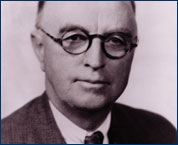
Bruce Clark, first Director of UCMP.
|
 |
Bruce Clark, an invertebrate paleontologist, joined the faculty in 1918. The future of paleontology looked glorious and Alexander was pleased. She had great hopes and invested money in Merriam's research and her collecting expeditions. However, Merriam's interests shifted towards administration, the scientific community beyond Berkeley, and his passion for preserving wild areas (Mark 2005). He left Berkeley for the presidency of the Carnegie Institute (1921 to 1938) in Washington, DC, but remained connected to the Paleontology Department. Alexander was unhappy with Merriam, his move, his failure to acknowledge the University, and his meddling in paleontology. A bitter relationship developed between them (Stein 2001). She countered Merriam by pressuring UC with increased funding for a Museum of Paleontology that would exclude Merriam from the Department. The University then established UCMP in 1921 with Bruce Clark as Director. Merriam continued to lobby for his own aims, creating so much indecision and discord that Paleontology once again fused with Geology. Clark remained a professor in geology, along with two new vertebrate paleontologists: Chester Stock and John Buwalda, both students and collaborators of Merriam's. In UCMP, Clark was joined by Charles Camp, a student of Grinnell. Merriam, aided by Stock, still intervened in the affairs of the department and UCMP, which caused Clark to resign the directorship in 1926. After some delay, the University appointed Ralph Chaney, a paleobotanist, as Director of UCMP, but Alexander, thinking this was more Merriam interference, withdrew all support for the museum (Stein 2001). The administration then changed its course and recanted its offer to Chaney.
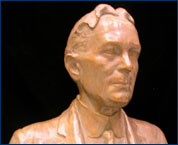
A bust of William Diller Matthew sculpted by his daughter, Margaret Matthew Colbert. At least two copies were cast in the laboratories of the American Museum of Natural History by Otto Falkenbach. One is now housed in UCMP's offices in the Valley Life Sciences Building.
|
 |
In 1927, William Diller Matthew was appointed director of UCMP and chairman of the reestablished Paleontology Department. His outstanding 33-year record at the American Museum of Natural History and his manner, induced tranquility on the museum and department. Alexander's hopes and financial support were renewed but this lasted only three years before Matthew passed away in 1930. This began yet another round of disputes in paleontology. Alexander met with President Gordon Sproul agreeing that Camp be Director of UCMP and that she would continue her support of its activities. Sproul wanted Ralph Chaney, Merriam's own choice, as chairman of Paleontology. Alexander was dismayed and difficulties between UCMP and the department grew around how her gifts to UCMP would be used. She again met with Sproul to urge a complete separation of the Museum from the Department, physically and financially, with separate staffs. Camp would run UCMP, and others, especially Merriam, would have no say in it at all. If Sproul did these, then her support would remain; if not, she would withdraw it. The university agreed to her demands, and the two units and their leaders were separated completely (Stein 2001). Alexander wanted better facilities for UCMP, so it moved to the Hearst Memorial Mining Building in 1931 where it remained for 30 years. Merriam went on to publish on vertebrate paleontology and to push successfully for state and national parks for wilderness areas (Mark 2005).
In spite of tensions between Paleontology and UCMP, both ran fairly smoothly. In 1934, Alexander endowed UCMP with the funds she had promised in 1921. She continued support and in 1948 made a final contribution to the UCMP endowment. Annie Alexander died in 1950, having donated substantial and nearly equal sums to UCMP and MVZ for research and student support. Both museums today benefit from her generosity and foresight.
References
- Mark, S.R. 2005. Preserving the living past — John C. Merriam's legacy in the state and national parks. University of California Press, Berkeley. 204 pp.
- Stein, B.R. 2001. On Her Own Terms, Annie Montague Alexander and the Rise of Science in the American West. University of California Press, Berkeley. 380 pp.





